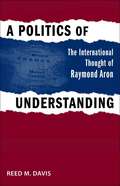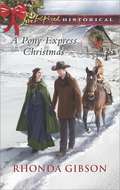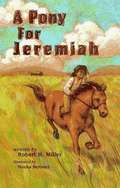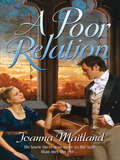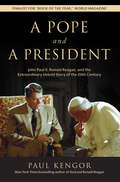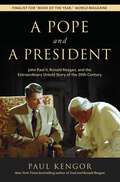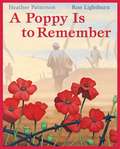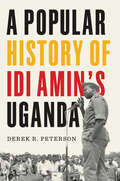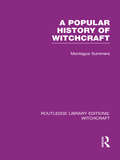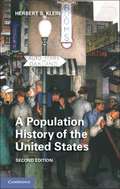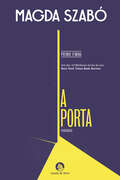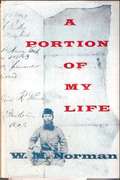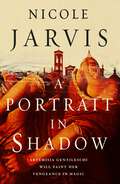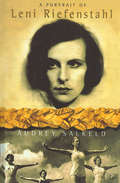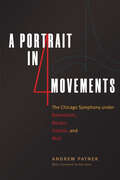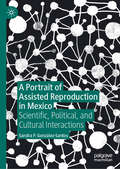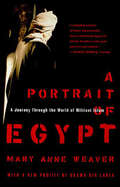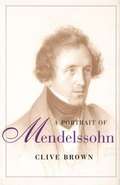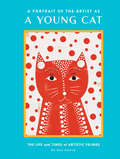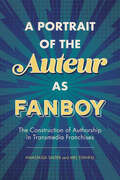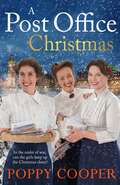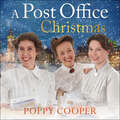- Table View
- List View
A Politics of Understanding: The International Thought of Raymond Aron (Political Traditions in Foreign Policy Series)
by Reed M. DavisFrequently hailed as one of the greatest defenders of democratic liberalism in postwar Europe, French philosopher, sociologist, and political commentator Raymond Aron (1905--1983) left behind a staggering amount of published work on a remarkably wide range of topics both scholarly and popular. In A Politics of Understanding, Reed M. Davis assesses the originality and consistency of Aron's body of work, drawing a connection between Aron's philosophy of history and three of his abiding interests: the nature of industrial society, international relations theory, and strategic theory.Davis begins with a brief biography of Aron, known for his skepticism toward political ideologies in the post--World War II era and as an intellectual opponent of Jean-Paul Sartre. After spending three years in Germany in the early 1930s, Aron, a Jew, returned to France in 1933. When war broke out, he fought for a year in the French army and, after the fall of France, escaped to London, where he edited the newspaper of the Free French, La France Libre. He returned to Paris after the war and remained there for the rest of his life, working as a professor and journalist. He wrote an influential political column for Le Figaro for thirty years and authored many books, including The Opium of the Intellectuals (1935), The Algerian Tragedy (1957), and Peace and War (1962).From World War II onward, Davis shows, Aron sought to construct a science of human action that had as its goal charting the way of human progress in light of two fundamental realities, industrialization and the existence of nuclear weapons. Throughout his long career, he continually asked himself whether human life was becoming better as it became more technologically rationalized and more scientifically advanced. In his close analysis of Aron's thought, Davis carefully describes how Aron fused Max Weber's neo-Kantianism with Edmund Husserl's phenomenology to create an original theory of historical knowledge. The central theoretical impulse in all of Aron's works, Davis explains, is that of reconciling freedom and necessity. The ways in which Aron attempted to reconcile these two polarities in his earliest writings had a direct bearing on the manner in which he sought to reconcile realism and idealism in his international thought. By attempting to bring reason and necessity into the same loose orbit, Aron tried to construct a theoretical approach to international relations and statecraft that could hold the middle ground between realism and idealism. Many scholars have simply abandoned efforts to understand the more philosophical dimensions of Aron's thinking because of its technical difficulty. With A Politics of Understanding, Davis provides a concise and clearly written explanation of the basic concepts at work in Aron's philosophy and ties them directly to his later thinking, especially concerning international relations.
A Pony Express Christmas
by Rhonda GibsonMISTLETOE MARRIAGE OF CONVENIENCE When Jake Bridges suddenly finds himself the guardian of his orphaned niece, he knows he needs a wife. What does a stock tender at a pony express station know about raising little girls? A marriage of convenience to the child's caretaker is the most practical solution. A mail-order marriage seems like Leah Hollister's last chance to know the simple joys of family life. But then she receives word that her would-be groom is dead. Now Jake proposes she marry him. She knows love isn't necessary. Yet the more she learns of sweet Molly's kindhearted uncle, the more she dreams of a true partnership with the man who has unexpectedly captured her heart.
A Pony for Jeremiah
by Robert H. MillerAfter running away from the Mississippi plantation where they had been slaves, nine-year-old Jeremiah Johnson and his family begin a new life in Nebraska, where Jeremiah meets a Cheyenne boy who becomes a good friend.
A Poor Relation
by Joanna MaitlandA WOMAN OF MYSTERY...Why would an impoverished gentlewoman masquerade as a sophisticated lady of the ton? Baron Amburley had a jaundiced enough view of women to suspect only one reason. Miss Isabella Winstanley was cold-bloodedly masquerading above her station to land a rich husband! Determined to unmask the upstart, Amburley challenged Isabella to a race.But as they prepared for the big race, Amburley found himself captivated by the real Isabella. Her frank, open ways and manifest joy were so unlike anything he'd encountered with other women, he soon found himself wishing that he knew nothing of her deceit. For this Isabella was the kind of woman who could haunt a man's dreams....
A Pope and a President: John Paul II, Ronald Reagan, and the Extraordinary Untold Story of the 20th Century
by Paul KengorIn this fascinating new book, acclaimed scholar and bestselling author Paul Kengor tells the untold story of the partnership between Pope John Paul II and President Ronald Reagan, and how together they changed the course of world history. Kengor shows that the bond between the pope and the president ran deeper than anyone suspected, and that this bond drove the two leaders to confront what they knew to be the great evil of the twentieth century: Soviet communism. Reagan and John Paul almost didn’t have the opportunity to forge this relationship: In the spring of 1981, these world leaders took bullets from would-be assassins—within the span of six weeks. Kengor’s unique access to Reagan insiders and his tireless archival research allows him to reveal previously unknown details, including:The story of the 1982 meeting where the president and the pope confided their conviction that God had spared their lives a year earlier for the purpose of defeating the communist empire.Captivating new information on the attempted assassination of Pope John Paul II, including a heretofore-unreported secret investigation Reagan authorized—was Moscow behind the plot?The many similarities and the spiritual bond between the pope and the president—and how Reagan and a close adviser privately spoke of the “DP”: the Divine Plan to take down communism.New details about how the Protestant Reagan became fascinated by the “secrets of Fatima,” dating to the reported apparition of the Virgin Mary at Fatima, Portugal, starting on May 13, 1917—sixty-four years, to the day, before the attempt on John Paul’s life.An extraordinary insider account of how the Soviet Union may have been preparing to send troops into the pope’s native Poland and impose martial law in March 1981—only to pull back when news broke that Reagan had been shot.Shortly after leaving the White House, Reagan told three men from the Polish Solidarity movement that John Paul II was his “best friend”—a telling indicator of the kinship and supreme objective that united these two towering figures.
A Pope and a President: John Paul II, Ronald Reagan, and the Extraordinary Untold Story of the 20th Century
by Paul KengorEven as historians credit Ronald Reagan and Pope John Paul II with hastening the end of the Cold War, they have failed to recognize the depth or significance of the bond that developed between the two leaders. Acclaimed scholar and bestselling author Paul Kengor changes that. In this fascinating book, he reveals a singular bond—which included a spiritual connection between the Catholic pope and the Protestant president—that drove the two men to confront what they knew to be the great evil of the twentieth century: Soviet communism. Reagan and John Paul II almost didn't have the opportunity to forge this relationship: just six weeks apart in the spring of 1981, they took bullets from would-be assassins. But their strikingly similar near-death experiences brought them close together—to Moscow's dismay.Based on Kengor's tireless archival digging and his unique access to Reagan insiders, A Pope and a President is full of revelations. It takes you inside private meetings between Reagan and John Paul II and into the Oval Office, the Vatican, the CIA, the Kremlin, and many points beyond. Nancy Reagan called John Paul II her husband's "closest friend"; Reagan himself told Polish visitors that the pope was his "best friend." When you read this book, you will understand why. As kindred spirits, Ronald Reagan and John Paul II united in pursuit of a supreme objective—and in doing so they changed history.
A Popular History of Idi Amin's Uganda
by Derek R. PetersonHow Africa’s most notorious tyrant made his oppressive regime seem both necessary and patriotic Idi Amin ruled Uganda between 1971 and 1979, inflicting tremendous violence on the people of the country. How did Amin’s regime survive for eight calamitous years? Drawing on recently uncovered archival material, Derek Peterson reconstructs the political logic of the era, focusing on the ordinary people—civil servants, curators and artists, businesspeople, patriots—who invested their energy and resources in making the government work. Peterson reveals how Amin (1928–2003) led ordinary people to see themselves as front-line soldiers in a global war against imperialism and colonial oppression. They worked tirelessly to ensure that government institutions kept functioning, even as resources dried up and political violence became pervasive. In this case study of how principled, talented, and patriotic people sacrificed themselves in service to a dictator, Peterson provides lessons for our own time.
A Popular History of Minnesota
by Norman K. RisjordWhat do Paul Bunyan, Charles Lindbergh, and Jesse Ventura have in common? Minnesota, of course! In A Popular History of Minnesota, historian Norman K. Risjord offers a grand tour of the state's remarkable history. This highly readable volume details everything from the glacial formation of the land to the arrival of the Dakota and the Ojibwe people, from Minnesota's contributions to the Northern cause during the Civil War to the key players in reform politics who helped sculpt the identity the state retains today.
A Popular History of Witchcraft: Montague Summers (Routledge Library Editions: Witchcraft)
by Montague SummersThis is a comprehensive guide to the practices of witchcraft from their inception to the present day. Summers argues that all witchcraft is essentially the same, regardless of geographical location. He examines the practices of the cult in great detail, and its historical progression, within the context of the 1736 Repeal Act of George II.
A Population History of the United States
by Herbert S. KleinThe first full-scale, one-volume survey of the demographic history of the United States has been fully updated here. From the arrival of humans in the Western Hemisphere to the current century, Klein analyses the basic demographic trends in the growth of the pre-conquest, colonial and national populations. From the origin and distribution of the Native Americans to late 20th century changes in family structure, fertility and mortality, this updated edition incorporates recent research, including data from the 2010 census. In this definitive study, Klein explores regional patterns of fertility and mortality, trends in births, deaths and international and internal migrations, comparing them with contemporary European developments. The profound impact of historic declines in disease and mortality rates on the population structure of the late-20th century is explained, while the more recent urbanisation and rise of suburbia are examined within the context of new massive international migrations on North American society.
A Porta
by Magda SzabóUm dos romances mais célebres de Magda Szabó e vencedor do Prémio Femina Étranger, A Porta narra a relação vital entre uma escritora e a sua empregada doméstica,ao mesmo tempo que evoca a história da Hungria do século XX. Romance escrito em tom confessional e vagamente autobiográfico, A Porta narra a estreita relação que se estabelece entre duas mulheres na Hungria dos anos do pós-guerra: Magda, uma jovem escritora, e a sua empregada, Emerence, uma camponesa analfabeta. Magda, até então impedida de publicar, é politicamente reabilitada pelo regime, e torna-se escritora a tempo inteiro, alcançando, aos poucos, o merecido sucesso e reconhecimento social. Ao mudar-se para um apartamento maior, emprega Emerence para a ajudar com as lides domésticas. Esta é uma figura enigmática, respeitada e quase temida pela vizinhança, sobre a qual exerce uma autoridade natural, embora ninguém conheça verdadeiramente o seu passado ou a sua vida privada. A porta de sua casa está sempre fechada. A inesperada e dramática doença do marido de Magda reforçará a ligação e intimidade entre as duas mulheres, as quais, não obstante as enormes diferenças que as separam, estabelecem uma insólita relação de dependência e confiança mútua, que fará Emerence abrir a porta de sua casa a Magda, revelando-lhe os segredos de um passado traumático, ao mesmo tempo que precipita um final trágico na sua relação. Tradução directa do húngaro pelo reconhecido escritor e ensaísta Ernesto Rodrigues. «Um romance que altera o modo como entendemos a nossa própria vida. Uma obra de grande honestidade e delicadeza que expõe a complexa inadequação da comunicação humana, ao mesmo tempo que evoca a agonia da história recente da Hungria.» The New York Times «Uma obra de arte. Um dos triunfos alcançados por Szabó foi ter escrito uma obra profundamente política, enraizada na vida doméstica.» London Review of Books «Um texto brilhante, soberbo e desconcertante.» Le Figaro «Uma confissão inesquecível.» Lire «Um dos mais belos romances europeus do século xx.» ípsilon
A Portion Of My Life; Being Of Short & Imperfect History Written While A Prisoner Of War On Johnson’s Island, 1864
by Captain William M. NormanWhile a Confederate prisoner of war on Johnson's Island, William Norman wrote what he calls a "short diary or sketch" - a summing up of the important events of his life before he was captured at Kellysford Virginia, in 1863. Born into a hard working but somewhat poor family in Surry County, North Carolina; the future Confederate Captain lived a life out on the frontiers in Iowa and Nebraska as a schoolteacher, clerk and farmer with varied success. When the Civil War broke out he was a practicing lawyer in his native state and quickly took up arms in the Second North Virginia regiment; he fought in the army of Northern Virginia at the great battles of Fredericksburg, Chancellorsville and Gettysburg before his capture.
A Portrait In Shadow
by Nicole JarvisEnter a sumptuous world of art and magic in 17th-century Florence as Artemisia Gentileschi fights to make her mark as a painter and exact her revenge – perfect for fans of Alix E. Harrow, Elena Ferrante and Susanna Clarke.When Artemisia Gentileschi arrives in Florence seeking a haven for her art, she faces instant opposition from the powerful Accademia, self-proclaimed gatekeepers of Florence&’s magical art world. As artists create their masterpieces, they add layer upon layer of magics drawn from their own life essence, giving each work the power to heal – or to curse. The all-male Accademia jealously guards its power and has no place for an ambitious young woman arriving from Rome under a cloud of scandal. Haunted by the shadow of her harrowing past and fighting for every commission, Artemisia begins winning allies among luminaries such as Galileo Galilei, the influential Cristina de&’ Medici and the charming, wealthy Francesco Maria Maringhi. But not everyone in Florence wants to see Artemisia succeed, and when an incendiary preacher turns his ire from Galileo to the art world, Artemisia must choose between revenge and her dream of creating a legacy that will span the generations.
A Portrait Of Leni Riefenstahl
by Audrey SalkeldLeni Riefenstahl will always be remembered for her brilliant film of the 1936 Olympic Games in Berlin - still rated as one of the best documentaries ever made. Before that she was acclaimed for her roles in silent feature films, when German cinema was in its artistic heyday in the 1920s. She pioneered the box office success of such classic mountaineering dramas as The White Hell of Piz Palu and then began to direct her own films. The Blue Light was admired by Hitler and led to her filming the Wagnerian Nuremberg Rally of 1934. After the war she was shunned by the film industry, despite a court in 1952 proclaiming her not guilty of supporting the Nazis in a punishable way. Her undoubted charisma led to many affairs and grandiose schemes - deep sea diving in her seventies and still filming wildlife in her nineties. Audrey Salkeld has sifted the fact from the legend and gives us a moving portrait of the great movie `star' who suffered more in the `wilderness' than her enduring fame suggests.
A Portrait in Four Movements: The Chicago Symphony under Barenboim, Boulez, Haitink, and Muti
by Andrew Patner“Playing in an orchestra in an intelligent way is the best school for democracy.”—Daniel Barenboim The Chicago Symphony Orchestra has been led by a storied group of conductors. And from 1994 to 2015, through the best work of Daniel Barenboim, Pierre Boulez, Bernard Haitink, and Riccardo Muti, Andrew Patner was right there. As music critic for the Chicago Sun-Times and WFMT radio, Patner was able to trace the arc of the CSO’s changing repertories, all while cultivating a deep rapport with its four principal conductors. This book assembles Patner’s reviews of the concerts given by the CSO during this time, as well as transcripts of his remarkable radio interviews with these colossal figures. These pages hold tidbits for the curious, such as Patner’s “driving survey” that playfully ranks the Maestri he knew on a scale of “total comfort” to “fright level five,” and the observation that Muti appears to be a southpaw on the baseball field. Moving easily between registers, they also open revealing windows onto the sometimes difficult pasts that brought these conductors to music in the first place, including Boulez’s and Haitink’s heartbreaking experiences of Nazi occupation in their native countries as children. Throughout, these reviews and interviews are threaded together with insights about the power of music and the techniques behind it—from the conductors’ varied approaches to research, preparing scores, and interacting with other musicians, to how the sound and personality of the orchestra evolved over time, to the ways that we can all learn to listen better and hear more in the music we love. Featuring a foreword by fellow critic Alex Ross on the ethos and humor that informed Patner’s writing, as well as an introduction and extensive historical commentary by musicologist Douglas W. Shadle, this book offers a rich portrait of the musical life of Chicago through the eyes and ears of one of its most beloved critics.
A Portrait of Assisted Reproduction in Mexico: Scientific, Political, and Cultural Interactions
by Sandra P. González-SantosThis book paints a comprehensive portrait of Mexico’s system of assisted reproduction first from a historical perspective, then from a more contemporary viewpoint. Based on a detailed analysis of books and articles published between the 1950s and 1980s, the first section tells the story of how the epistemic, normative, and material infrastructure of the assisted reproduction system was built. It traces the professionalization process of assisted reproduction as a medical field and the establishment of its professional association. Drawing on ethnographic material, the second part looks at how this system developed and flourished from the 1980s up to 2010, its commercialization process, how the expansion of reproductive services took place, and the messages regarding reproductive technologies that circulated within a wide discursive landscape. Given its scope and methods, this book will appeal to scholars interested in science and technology studies, reproduction studies, history of medicine, medical anthropology, and sociology.
A Portrait of Egypt: A Journey Through the World of Militant Islam
by Mary Anne WeaverFor centuries Egypt has been a citadel of Islamic learning and thought, and since the signing of the Egyptian-Israeli Peace Treaty in 1979, it has been of immense strategic importance to American interests in the Middle East. But Egypt is also a country in crisis, torn between the old and the new, between unsettled religious revival and secular politics. President Hosni Mubarak favors a secular society. But Mubarak's government faces constant conflict with militant clerics such as Sheikh Omar Abdel-Rahman. In A Portrait of Egypt, Mary Anne Weaver argues that an Islamist victory in Egypt is almost inevitable, and, unlike that of Shi'ite Iran, its impact on the Islamic world will be truly profound.Based on exclusive interviews with militants and front men, generals and presidents, A Portrait of Egypt is essential reading for anyone trying to understand the far-reaching consequences of the growing impact of Islamist politics and policies on the West.
A Portrait of Mendelssohn
by Clive BrownClive Brown draws a different picture of Felix Mendelssohn's personality and work.
A Portrait of the Artist as a Young Cat: Life and Times of Artistic Felines
by Nia GouldA Portrait of the Artist as a Young Cat is a book of more than 20 influential artists reimagined as artistic felines.From Frida Catlo to Yayoi Catsama, Wassily Catdinski to Henri Catisse, each portrait of the artist as a young cat is accompanied by a clever tongue-in-cheek biography revealing the thrilling feline lives (all nine) behind their famed artwork.Loaded with clever cat puns, this playful romp through art history will twist the whiskers of any cat-loving creative, whether you're discovering the inspiration for Frida Catlo's renowned self-pawtraits to reflecting on the catmosphere that gave rise to Georgia O'Kitty's landscapes.• Features fantastic feline artists such as Mary Catsatt and Meow Weiwei• A cute and clever book that cat and art lovers alike will love• Packed with tons of real biographical info about each artist and plentiful cat punsFor cat lovers with an artistic purr-suasion, this is the ultimate celebration of their favorite artists.• A purrfectly smart and sweet book for cat lovers, art lovers, pun enthusiasts, and those who love them• Great for those who loved Fat Cat Art by Svetlana Petrova, Cats Galore by Susan Herbert, Of Cats and Men: Profiles of History's Great Cat-Loving Artists, Writers, Thinkers and Statesmen by Sam Kalda
A Portrait of the Auteur as Fanboy: The Construction of Authorship in Transmedia Franchises
by Anastasia Salter Mel StanfillIncreasingly over the past decade, fan credentials on the part of writers, directors, and producers have come to be seen as a guarantee of quality media making—the “fanboy auteur.” Figures like Joss Whedon are both one of “us” and one of “them.” This is a strategy of marketing and branding—it is a claim from the auteur himself or industry PR machines that the presence of an auteur who is also a fan means the product is worth consuming. Such claims that fan credentials guarantee quality are often contested, with fans and critics alike rejecting various auteur figures as the true leader of their respective franchises. That split, between assertions of fan and auteur status and acceptance (or not) of that status, is key to unravelling the fan auteur.In A Portrait of the Auteur as Fanboy: The Construction of Authorship in Transmedia Franchises, authors Anastasia Salter and Mel Stanfill examine this phenomenon through a series of case studies featuring fanboys. The volume discusses both popular fanboys, such as J. J. Abrams, Kevin Smith, and Joss Whedon, as well as fangirls like J. K. Rowling, E L James, and Patty Jenkins, and dissects how the fanboy-fangirl auteur dichotomy is constructed and defended by popular media and fans in online spaces, and how this discourse has played in maintaining the exclusionary status quo of geek culture. This book is particularly timely given current discourse, including such incidents as the controversy surrounding Joss Whedon’s so-called feminism, the publication of Harry Potter and the Cursed Child, and contestation over authorial voices in the DC cinematic universe, as well as broader conversations about toxic masculinity and sexual harassment in Hollywood.
A Possible Peace Between Israel and Palestine: An Insider's Account of the Geneva Initiative
by Menachem KleinIn 2003, after two years of negotiations, a group of prominent Israelis and Palestinians signed a model peace treaty. The document, popularly called the Geneva Initiative, contained detailed provisions resolving all outstanding issues between Israel and the Palestinian people, including drawing a border between Israel and Palestine, dividing Jerusalem, and determining the status of the Palestinian refugees.The negotiators presented this citizens' initiative to the Israeli and Palestinian peoples and urged them to accept it. One of the Israeli negotiators was Menachem Klein, a political scientist who has written extensively about the Jerusalem issue in the context of peace negotiations. Although the Geneva Initiative was not endorsed by the governments of either side, it became a fundamental term of reference for solving the Middle East conflict. In this firsthand account, Klein explains how and why these groups were able to achieve agreement. He directly addresses the formation of the Israeli and Palestinian teams, how they managed their negotiations, and their communications with both governments. He also discusses the role of third-party facilitators and the strategy behind marketing the Geneva Initiative to the public.A scholar and participant in the Geneva negotiations, Klein is able to provide both an inside perspective and an impartial analysis of the diplomatic efforts behind this historic compromise. He compares the negotiations to previous Israeli-Palestinian talks both formal and informal and the resolution of conflicts in South Africa and Algeria. Klein hopes that by treating the event as a case study we can learn a tremendous amount about the needs and approaches of both parties and the necessary shape peace must take between them.
A Post Office Christmas: Book Two in a lively, uplifting new WW1 saga series
by Poppy CooperCurl up with the perfect festive saga read! Can they deliver hope and friendship this Christmas? 1915. After the recent dramatic events at the Home Depot, Milly Woods is looking forward to spending as much time as possible with her Post Office girls, Nora and Beth - known as Liza to her friends. With Christmas fast approaching, their job of getting millions of letters and parcels to the troops on the front line is more important than ever.But when Milly is moved to a different department, she and the girls struggle to find time to spend together. Feeling more and more lonely, Milly finds company and common ground at her local suffragette group - as well as catching the eye of a wounded ex-soldier at the Home Depot.But soon, Milly discovers that her new friends might not be what they seem. As she is drawn into a deadly plan that could affect the outcome of the war, can her Post Office girls help her get back on track, and scupper the plan in time for Christmas?READERS LOVE THE POST OFFICE GIRLS!'A superb debut novel' - 5 STARS'Entertaining, enlightening and thoroughly enjoyable' - 5 STARS'I absolutely loved this book and I am already eagerly awaiting book two in the series' - 5 STARS'The book gave a wonderful in sight into postal-service life during the war. Well done, Poppy' - 5 STARS'An excellent WW1 book' - 5 STARS
A Post Office Christmas: Book Two in a lively, uplifting new WW1 saga series
by Poppy CooperCurl up with the perfect festive saga read! Can they deliver hope and friendship this Christmas? 1915. After the recent dramatic events at the Home Depot, Milly Woods is looking forward to spending as much time as possible with her Post Office girls, Nora and Beth - known as Liza to her friends. With Christmas fast approaching, their job of getting millions of letters and parcels to the troops on the front line is more important than ever.But when Milly is moved to a different department, she and the girls struggle to find time to spend together. Feeling more and more lonely, Milly finds company and common ground at her local suffragette group - as well as catching the eye of a wounded ex-soldier at the Home Depot.But soon, Milly discovers that her new friends might not be what they seem. As she is drawn into a deadly plan that could affect the outcome of the war, can her Post Office girls help her get back on track, and scupper the plan in time for Christmas?READERS LOVE THE POST OFFICE GIRLS!'A superb debut novel' - 5 STARS'Entertaining, enlightening and thoroughly enjoyable' - 5 STARS'I absolutely loved this book and I am already eagerly awaiting book two in the series' - 5 STARS'The book gave a wonderful in sight into postal-service life during the war. Well done, Poppy' - 5 STARS'An excellent WW1 book' - 5 STARS
A Post Office Christmas: Book Two in a lively, uplifting new WW1 saga series
by Poppy CooperCan they deliver hope and friendship this Christmas? 1915. After the recent dramatic events at the Home Depot, Milly Woods is looking forward to spending as much time as possible with her Post Office girls, Nora and Beth - known as Liza to her friends. With Christmas fast approaching, their job of getting millions of letters and parcels to the troops on the front line is more important than ever.But when Milly is moved to a different department, she and the girls struggle to find time to spend together. Feeling more and more lonely, Milly finds company and common ground at her local suffragette group - as well as catching the eye of a wounded ex-soldier at the Home Depot.But soon, Milly discovers that her new friends might not be what they seem. As she is drawn into a deadly plan that could affect the outcome of the war, can her Post Office girls help her get back on track, and scupper the plan in time for Christmas?
